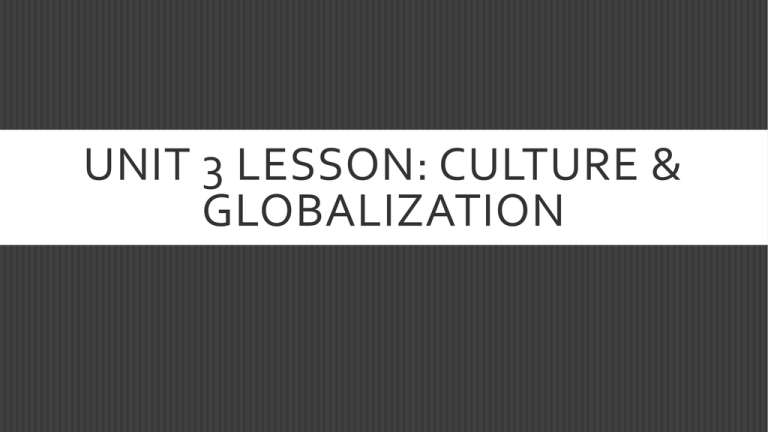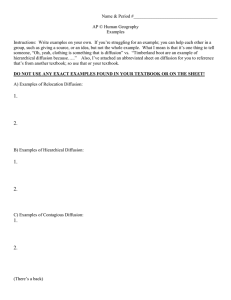Unit 3 Lesson Folk and Pop and Globalization
advertisement

UNIT 3 LESSON: CULTURE & GLOBALIZATION STUDENT WILL BE ABLE… Aspects of culture such as assimilation and acculturation and the role that technology/globalization plays in assimilation. DIFFUSION Remembering the concepts of diffusion are key to understanding culture. It is about how things to different places. Diffusion: “movement of people, ideas, or things form one location outward toward other locations where these items are not initially found” (Domosh, 2010). This is how religion, food preferences, sports, housing preferences, or all of those cultural traits get to different places. DIFFUSION CONT. (TWO BIG TYPES) Relocation Diffusion: “Occurs when individuals or groups with a particular idea or practice migrate from one location to another, there by brining the idea or practice to their new homeland” (Domosh, 2010). Traits of folk culture are typically spread through relocation diffusion because of limited interaction with others/outside. Expansion Diffusion: “spread throughout a population, from area to area, in a snowballing process, so that the total number of knowers or users and the areas of occurrence increase” (Domosh, 2010). This is what pop culture will typically use; media will spread it pretty quickly; but think of a “viral video” or something people are sharing rapidly. TYPES OF EXPANSION DIFFUSION (YEAH, WE DIDN’T DISTINGUISH BEFORE, BUT NOW WE ARE) Hierarchical Diffusion: “ideas leapfrog from one important person to a another or from one urban center to another.” Example: Sushi Restaurants originally were in Japan, but then spread to New York City, Los Angeles, and other large cities. Contagious Diffusion: “Involves the wavelike spread of ideas in a manner of a contagious disease, moving throughout space without regard to hierarchies” (Domosh, 2010). Example: HIV/AIDS originally was spread through hierarchical diffusion (large cities), but then it turned into contagious diffusion. Relocation also turn into contagious. Stimulus diffusion: “specific trait is rejected, but the underlying idea is accepted” (Domosh, 2010). Example: Siberians didn’t domesticate cattle, but took the concept and domesticated reindeer. GLOBALIZATION Globalization: “refers to a world increasingly linked, in which international borders are diminished in importance and a worldwide marketplace is created” (Domosh, 2010). Technology has facilitated this process; initially faster more reliable transportation. (Always make sure you clarify what kind of transportation when asked; cars, planes, trains, etc.) The internet (which is discussed at length in Rubeinstein) has also played a huge role in creating relationships and linkages between places. JOHN BORCHERT (NOT IN THE TEXTBOOK) OR: BORCHERT’S EPOCH’S OF TRANSPORTATION We will spend more time with Borchert when we do urban, but I mention the Epoch’s of Transportation so that when you are thinking about a time/place and diffusion, you put it in the context of transportation and hopefully visual better… Stage 1: Sail and Wagon Period 1790-1830 Stage 2: Iron-Horse Period 1830-1870 Stage 3: Steel Rail Period 1870-1920 Stage 4: Auto-Air-Amenity period 1920-1960 Stage 5: High Technology Epoch FOLK V. POP CULTURE & GLOBALIZATION Negative of globalization is that it erodes the uniqueness of a place, creating a sense of “placelessness” or no place really being distinct. Acculturation: “process by which one culture group undergoes a major modification by adopting many of the characteristics of another.” A good way to remember acculturation is the hard “C’s”. Acculturation is a rough process, where a lot of times a behavior is forced on someone else and is more like creating salad with distinct parts. Example: In things Fall Apart they were forced into the British government system. Assimilation: “The social process of merging into a composite culture, losing separate ethic or social identity.” A good way to remember this one is the smooth “S’s”. It’s a smother transition and you can’t distinguish. It’s soup vs. salad. Example: Things Fall Apart, the son who choose to be a Christian. https://www. youtube.com /watch?v=nL TjpGeEZVY




